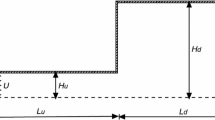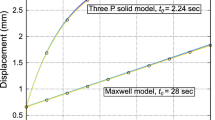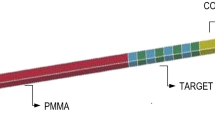Abstract
In this paper we investigate flow localization in viscoplastic slender bars subjected to dynamic tension. We explore loading rates above the critical impact velocity: the wave initiated in the impacted end by the applied velocity is the trigger for the localization of plastic deformation. The problem has been addressed using two kinds of numerical simulations: (1) one-dimensional finite difference calculations and (2) axisymmetric finite element computations. The latter calculations have been used to validate the capacity of the finite difference model to describe plastic flow localization at high impact velocities. The finite difference model, which highlights due to its simplicity, allows to obtain insights into the role played by the strain rate and temperature sensitivities of the material in the process of dynamic flow localization. Specifically, we have shown that viscosity can stabilize the material behavior to the point of preventing the appearance of the critical impact velocity. This is a key outcome of our investigation, which, to the best of the authors’ knowledge, has not been previously reported in the literature.








Similar content being viewed by others
References
ABAQUS/Explicit: Abaqus Explicit User’s Manual, Version 6.10. ABAQUS Inc., Richmond (2010)
Belytschko, T.: An overview of semidiscretization and time integration procedures. In: Computational Methods for Transient Analysis, pp. 1–95 (1983)
Belytschko, T., Hsieh, B.J.: Nonlinear transient finite element analysis with convected coordinates. Int. J. Numer. Methods Eng. 7, 255–271 (1973)
Bridgman, P.W.: The stress distribution at the neck of a tensile specimen. Trans. Am. Soc. Met. 32, 553–574 (1944)
Bridgman, P.W.: Studies in large plastic flow and fracture, with special emphasis on the effects of hydrostatic pressure, vol. 1. McGraw–Hill Book Company, Inc., New York (1952)
Clark, D.S., Wood, D.S.: The influence of specimen dimension and shape on the results in tension impact testing. Proc. Am. Soc. Test. Mater. 50, 577–585. (1950a)
Clark, D.S., Wood, D.S.: The tensile impact properties of some metals and alloys. Trans. Am. Soc. Met. 42, 45–74 (1950b)
Duwez, P.E., Clark, P.E.: An experimental study of the propagation of plastic deformation under conditions of longitudinal impact. Proc. Am. Soc. Test. Mater. 47, 502–532 (1947)
Fish, J., Shek, K.: Finite deformation plasticity based on the additive split of rate of deformation and hyperelasticity. Comput. Methods Appl. Mech. Eng. 190, 75–93 (2000)
Gosh, A.K.: Tensile instability and necking in materials with strain hardening and strain-rate hardening. Acta Metall. 25, 1413–1424 (1977)
Hughes, T.J.R., Winget, J.: Finite rotation effects in numerical integration of rate constitutive equations arising in large-deformation analysis. Int. J. Numer. Methods Eng. 15, 1862–1867 (1980)
Hutchinson, J.W., Neale, K.W.: Influence of strain rate sensitivity on necking under uniaxial tension. Acta Metall. 25, 839–846 (1977)
Klepaczko, J.R.: Review on critical impact velocities in tension and shear. Int. J. Impact Eng. 32, 188–209 (2005)
Klepaczko, J.R.: Introduction to Experimental Techniques for Material Testing at High Strain Rates. Scientific Library, Warszawa Institute of Aviation, Warszawa (2007)
Klöcker, H., Tvergaard, V.: Growth and coalescence of non-spherical voids in metals deformed at elevated temperature. Int. J. Mech. Sci. 45, 1283–1308 (2003)
Mann, H.C.: High-velocity tension-impact tests. Proc. Am. Soc. Test. Mater. (1945) 36, 85–109 (1936)
Molinari, A.: Collective behaviour and spacing of adiabatic shear bands. J. Mech. Phys. Solids 45, 1551–1575 (1997)
Needleman, A.: Material rate dependence and mesh sensitivity in localization problems. Comput. Methods Appl. Mech. Eng. 67, 69–85 (1988)
Needleman, A.: The effect of material inertia on neck development. In: Topics in Plasticity, pp. 151–160. AM Press, Ann Arbor (1991)
Needleman, A., Tvergaard, V.: Analyses of plastic flow localization in metals. Appl. Mech. Rev. 45, S3–S18 (1992)
Needleman, A.: Effect of size on necking of dynamically loaded notched bars. Mech. Mater. 116, 180–188 (2018)
Nemat-Nasser, S.: On finite deformation elasto-plasticity. Int. J. Solids Struct. 18, 857–872 (1982)
Rashid, M.M.: Incremental kinematics for finite element applications. Int. J. Numer. Methods Eng. 36, 3937–3956 (1993)
Regazzoni, G., Johnson, J.N., Follansbee, P.S.: Theoretical study of the dynamic tensile test. Int. J. Appl. Mech. 53, 519–528 (1986)
Rodríguez-Martínez, J.A., Rusinek, A., Arias, A.: Relation between strain hardening of steel and critical impact velocity. J. Theor. Appl. Mech. 47, 645–665 (2009)
Rodríguez-Martínez, J.A., Vadillo, G., Fernández-Sáez, J., Molinari, A.: Identification of the critical wavelength responsible for the fragmentation of ductile rings expanding at very high strain rates. J. Mech. Phys. Solids 61, 1357–1376 (2013)
Rusinek, A., Klepaczko, J.R.: Impact tension of sheet metals—effect of initial specimen length. J. Phys. IV(10), 329–334 (2003)
Rusinek, A., Zaera, R., Klepaczko, J.R., Cheriguene, R.: Analysis of inertia and scale effects on dynamic neck formation during tension of sheet steel. Acta Mater. 53, 5387–5400 (2005)
Simó, J.C., Pister, K.S.: Remarks on the rate constitutive equations for finite deformation problems: computational implications. Comput. Methods Appl. Mech. Eng. 46, 201–215 (1984)
Souza Neto, de, E., Peric, D., Owen, D.: Computational Methods for Plasticity: Theory and Applications. Wiley, New York (2008)
Vaz-Romero, A., Rodríguez-Martínez, J.A.: On the interplay between material flaws and dynamic necking. Mech. Res. Commun. 72, 53–58 (2016)
Vaz-Romero, A., Rodríguez-Martínez, J.A., Arias, A.: The deterministic nature of the fracture location in the dynamic tensile testing of steel sheets. Int. J. Impact Eng. 86, 318–335 (2015)
Vaz-Romero, A., Rotbaum, Y., Rodríguez-Martínez, J.A., Rittel, D.: Necking evolution in dynamically stretched bars: new experimental and computational insights. J. Mech. Phys. Solids 91, 216–239 (2016)
Wang, W., Sluys, L., de Borst, R.: Viscoplasticity for instabilities due to strain softening and strain-rate softening. Int. J. Numer. Methods Eng. 40, 3839–3864 (1997)
Wood, W.W.: Experimental mechanics at velocity extremes—very high strain rates. Exp. Mech. 5, 361–371 (1965)
Xue, Z., Vaziri, A., Hutchinson, J.W.: Material aspects of dynamic neck retardation. J. Mech. Phys. Solids 56, 93–113 (2008)
Zaera, R., Fernández-Sáez, J.: An implicit consistent algorithm for the integration of thermoviscoplastic constitutive equations in adiabatic conditions and finite deformations. Int. J. Solids Struct. 43, 1594–1612 (2006)
Zhou, F., Molinari, J.F., Ramesh, K.T.: An elasto–visco-plastic analysis of ductile expanding ring. Int. J. Impact Eng. 33, 880–891 (2006)
Zukas, J.A., Scheffer, D.R.: Practical aspects of numerical simulations of dynamic events: effects of meshing. Int. J. Impact Eng. 24, 925–945 (2000)
Acknowledgements
Helpful discussions with Guadalupe Vadillo are acknowledged.
The authors are indebted to the Spanish Ministry of Economy and Competitiveness (Projects EUIN2015-62556 and DPI2014-57989-P) for the financial support received which allowed conducting part of this work.
The research leading to these results has received funding from the European Union’s Horizon2020 Programme (Excellent Science, Marie-Sklodowska-Curie Actions) under REA grant agreement 675602 (Project OUTCOME).
Author information
Authors and Affiliations
Corresponding author
Appendix A: Mesh sensitivity analysis
Appendix A: Mesh sensitivity analysis
In this section we analyze the mesh sensitivity of finite difference and finite element computations. In the calculations of this section we consider the material properties given in Table 1. The impact velocity is \(\hat{V}^{\mathit{imp}}=0.01\).
1.1 A.1 Finite difference model
Figure 9 shows the equivalent plastic strain \(\hat{\bar{\varepsilon}}^{p}\) versus the normalized dimensionless coordinate \(\hat{Z}/\hat{L}\) for three different mesh densities: 500 nodes, 750 nodes and 1000 nodes. For \(\hat{t}=10\) (Fig. 9(a)) the curves obtained for the three different meshes virtually overlap each other. On the contrary, for \(\hat{t}=40\) (Fig. 9(b)), we observe a (slight) disagreement in the predictions obtained for 500, 750 and 1000 nodes. Such a mesh dependence of the results is always detected close to the impacted side where large gradients of plastic strain are developed. However, we have checked that it does not have implications in the analysis of the results presented in this paper. A mesh with 1000 nodes has been used to carry out all the finite difference computations reported in Sects. 5 and 6.
Finite difference results. Dimensionless impact velocity \(\hat{V}^{\mathit{imp}}=0.01\). Equivalent plastic strain \(\hat{\bar{\varepsilon}}^{p}\) versus normalized dimensionless coordinate \(\hat{Z}/\hat{L}\) for three different mesh densities: 500 nodes, 750 nodes and 1000 nodes (reference mesh). Dimensionless time: (a) \(\hat{t}=10\) and (b) \(\hat{t}=40\). The vertical yellow line delimits the zoomed area (For interpretation of the references to colour in the text, the reader is referred to the web version of this article)
1.2 A.2 Finite element model
Figure 10 depicts the equivalent plastic strain \(\hat{\bar{\varepsilon}}^{p}\) versus the normalized dimensionless coordinate \(\hat{Z}/\hat{L}\) for three different mesh densities: 1000, 1600 and 2000 elements along the axial direction, respectively. In any case the element aspect ratio is 1:1. The results presented correspond to two different loading times: \(\hat{t}=10\) in Fig. 10(a) and \(\hat{t}=40\) in Fig. 10(b). No differences are observed in the results presented for the three meshes. A mesh with 2000 elements along the axial direction has been used to carry out the finite element computations reported in Sect. 5.
Finite element results. Dimensionless impact velocity \(\hat{V}^{\mathit{imp}}=0.01\). Equivalent plastic strain \(\hat{\bar{\varepsilon}}^{p}\) versus normalized dimensionless coordinate \(\hat{Z}/\hat{L}\) for three different mesh densities: 1000 elements along the axial direction, 1600 elements along the axial direction and 2000 along the axial direction (reference mesh). Dimensionless time: (a) \(\hat{t}=10\) and (b) \(\hat{t}=40\). The vertical yellow line delimits the zoomed area (For interpretation of the references to colour in the text, the reader is referred to the web version of this article)
Rights and permissions
About this article
Cite this article
Vaz-Romero, A., Rodríguez-Martínez, J.A. A one-dimensional model to describe flow localization in viscoplastic slender bars subjected to super critical impact velocities. Mech Time-Depend Mater 23, 75–95 (2019). https://doi.org/10.1007/s11043-018-9378-z
Received:
Accepted:
Published:
Issue Date:
DOI: https://doi.org/10.1007/s11043-018-9378-z






